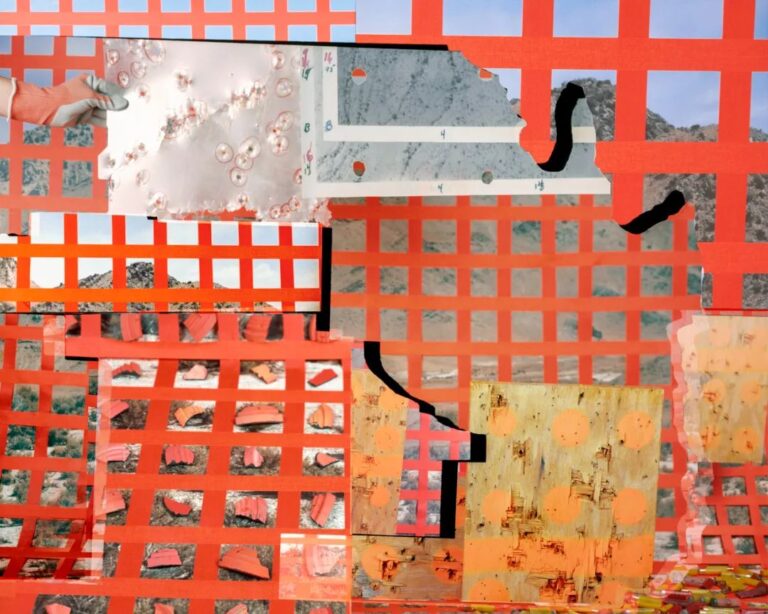Founded in 2012, GOST Books is one of the leading independent visual arts and photography publishers based in London. They pride themselves on a vast output of diverse subject matter and design. In our recent online themed exhibition, The Boundary of Drifting, GOST Books presents five great titles exploring photography. The related topics range from border issues and territorial conflicts to landscape depictions and the authenticity behind photojournalism.
GOST Books not only contributes to print legacies of masters in the medium but also aims to provide a platform for the work of emerging artists.
This year, GOST Books Publishing Award has partnered with Unseen Amsterdam to discover more unpublished work from unexpected perspectives and different backgrounds, with photographers making use of the medium in innovative, intelligent, inspiring and provocative ways. Jaclyn Wright is selected from 353 entrants for her project High Visibility (Blaze Orange).

© Jaclyn Wright, Untitled, from High Visibility (Blaze Orange), 2022. Courtesy of the artist & GOST Books
Here, we feature an interview with Stuart Smith, Director and Co-Founder of GOST Books to reveal his thoughts and opinions about the photography publishing industry.
From his perspective, independent publishers have an advantage over major publishers when it comes to photography and art industry because they can afford to use materials that may be more expensive, such as cloth covers, screen printing etc, due to the smaller print run. And after so many years of working as publishers, he still enjoys the process. He says, “The thing that motivates me is being involved in the process of editing and sequencing. It’s the engagement with the artists/photographers that make everything worthwhile.”
GOST Books was established in 2012. Could you share with us a little bit about the whole cultural environment/background of the photobooks in the UK or the western art world back at that time? What is the goal of GOST Books in the early days of the development?
At the time GOST was established in 2012, I had been working as a designer on art and photography books for several years but never from the publisher side. At that time there was a rise in self-publishing platforms in the UK (and worldwide), and we saw a lot of new awards and competitions being established specifically for photobooks. We started GOST because we felt we could do something exciting in photobook publishing from a distinctive, collaborative perspective.
Among all the books published by GOST Books, which one do you think is the most representative? Why?
That’s a bit like asking who is your favourite child.
Alexandra Rose Howland’s Leave and Let Us Go, Craig Easton’s Bank Top, Elliott Erwitt’s Found Not Lost, Mark Power’s Good Morning America series, Chloe Sell’s Hot Damn, Lu Nan’s Trilogy, Guy Martin’s Parallel State.
All these books are representative of GOST but each is different, some are more documentary and others are conceptual. But all of them have something original. A lot of our books require the viewer to work, you have to look beyond just the images to understand the point that is being made. This could be simply great photography, or a long-term project where the photographer has spent years collating and honing the concept.
GOST Books attaches great importance to diversity. Could you explain more about what is the diversity that GOST Books are looking for? Could you give us a great example of it? What kind of photography projects will be favoured by GOST Books?
All projects rooted in photography have a relevance for GOST, but we are interested in projects that are not necessarily finished. I see GOST in terms of a collaborator, and the book is the culmination of the photographer’s and GOST’s ideas.
We are not a packager, so if you came to us with a finished designed book, we probably won’t do it, unless it is fantastico, which has happened, Rafal Milach’s Winners designed by Ania Nałęcka-Milach, for example.
I like photography to pose questions not answers. I like photography to make me laugh or cry or make me outraged but not when it is bland and leaves me indifferent.
It is said that the best destination for photography is publishing, do you agree?
Yes. Photo books are beautiful objects, if care and attention is paid to them. We are tired of looking at a screen all day, you don’t get the same sequence and the same scale and texture and smell and the love that goes into producing a book. It’s organic and breathes and lives, and that’s its beauty.
It may not come as a surprise that I listen to vinyl records and not Spotify, because there is a craft to the production, and to listen to an album in a sequence selected by the artist, it’s a thing of beauty much like a photobook.
Rafal Milach's Winners designed by Ania Nałęcka-Milach, published by GOST Books
If publishing can be understood as a different kind of curation on paper, what are the core points of presenting photography through books/publications, as opposed to presenting photography in space?
There is a similarity to a space, the main thing is about simplicity, if the photography/concept is good then you don’t need to overdesign or overthink it. It doesn’t need fold out and fancy papers and tricks and gimmicks and fussiness, the more this goes into the book the more you know they are hiding something, covering up the fact that the idea is weak or the pictures are. But, like everything, there are exceptions to the rule.
In your opinion, what is the biggest difference between photobooks and other art publishing?
The main difference is the reproduction, we spend an enormous amount of money getting the pictures to be representative of what the artist/photographer is after. We encourage them to go on press to see the nuance as the book is printed and as I have said we create artist books made with love, not massed produced marketing exercises.